What Is a Minimum Viable Product (MVP)? Complex Guide for 2022
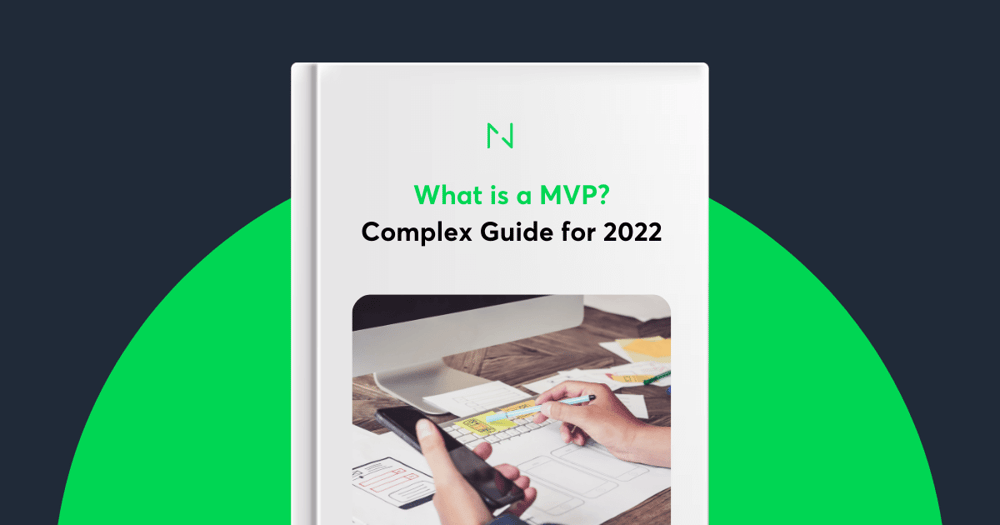
Introduction
Contents
Building an MVP is a great way for businesses to validate their ideas. 70% of tech startups fail within 2 years on from their first financing because they do not meet market needs - and this almost always stems from a lack of market research.
Using an MVP to run tests is a key step to avoiding this failure. It helps you to gather feedback from your potential customers and identify what they truly need from your product.
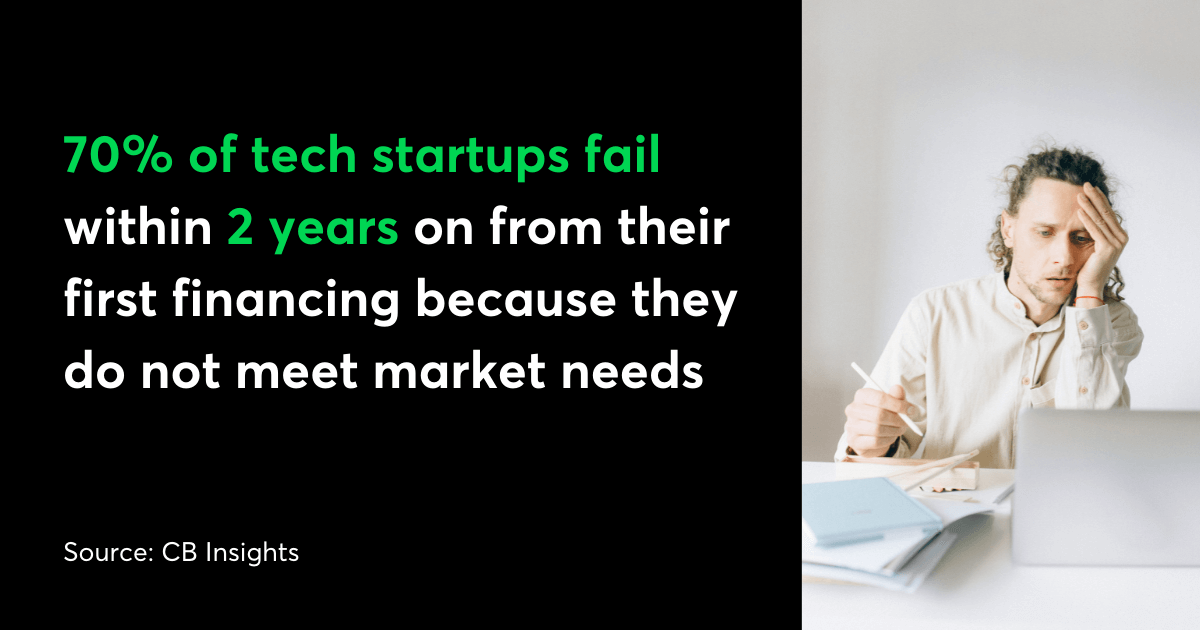
Using an MVP will enable you to validate the actual potential of your idea (versus the assumed potential of it) and guide the direction of the development process.
An MVP can be used by any company in any industry, with the aim of refining and launching products that gain momentum quickly, as well as a cost-effective way to promote your brands.
In this guide, we’ll be covering everything you need to know about developing a Minimum Viable Product, from different business approaches, to related benefits, costs -and potential applications.
We’ll also run through some of the jargon related to product development and MVP building.
By the end of this guide, you’ll have everything you need to begin building a minimum viable product.
What is Minimum Viable Product (MVP)? Definition

A minimum viable product is an early product version that has just enough features for early customers to be able to use it.
These customers then offer feedback which can be incorporated into future, more developed versions of the product.
The concept of the MVP was first originated by Eric Ries, as part of his Lean Startup Methodology.
By focusing on building and releasing an MVP in the early stages of product development, a brand can avoid having to make lengthy and unnecessary changes further down the line, as might happen if they release a full product to market without proper testing.
A successful MVP will reveal customers' real opinions and their desirability for the product.
Piotr Szczechowiak, Product Manager in Netguru
MVPs enable businesses to test, refine and launch products quickly, gaining traction with customers quicker than the competition.
It also gives early adopters a chance to interact with and connect to your product and can help to build and promote a certain image of your brand. It can be a real key asset in discovering the true expectations of your target audience.
By understanding their expectations and preferences, you can prioritise aspects of the product development more strategically, so you don’t waste time and resources on features your users don’t want or need.
There are four key aspects of MVP product development:
It’s essentially to select the features of your MVP carefully. An MVP is not a sketch or a frame of a product. It is a workable product, albeit one without any frills.
In that sense, it needs to have all of the components of a complete application: functional, reliable, usable and well-designed.
What is MVP in product management?
One of the key reasons startups fail is that the foundation of their product design is formed on false assumptions.
Many fall into the trap of assuming their product will solve a problem - better than any existing solution on the market. They also believe people care enough about the issue to pay for an answer. When these assumptions are incorrect, the startup remains grounded.
However, companies can also suffer even if their idea is a good one. Tom Eisenmann, in the Harvard Business Review, refers to this as ‘Good Ideas, Bad Bedfellows’, referring to when the product idea is sound, but one or more of the stakeholders involved in driving it just isn’t the right fit.
It’s important to ensure that the right team is in place - fulfilling the right roles - to bring your idea to life successfully.
That’s why it is important to create minimum viable products. It allows you to avoid these struggles by testing ideas to see how your potential users react to them.
The MVP is an important learning tool. The process of MVP development is not really about the product - it’s about validating an idea - are your customers going to use this product? If not, why not?
And then taking it from there to refine and add other useful features.
The MVP testing phase should gather as much user data and feedback as possible, using the least amount of resources.
How does this translate to product management?
In product management we often deal with limited resources, especially when it comes to time and money.
A product manager needs to prevent scope creep and manage stakeholders, driving home the point of putting out a minimum viable product in the first place.
As a result, it's wise to focus on building a simple MVP and iterate based on initial customer feedback.
Instead of risking overspending on features that don't end up being used, creating a product with just the core features will help the team quickly learn and make adjustments along the way to the final product.
What is the difference between Proof of Concept and Minimum Viable Product?
We need to remember that MVP is neither a prototype nor a Proof of Concept (PoC).
A prototype is a draft version of the product which demonstrates its visual form or certain parts of its functionality. Prototypes are usually discarded or end up in some form as a part of the MVP or final product.
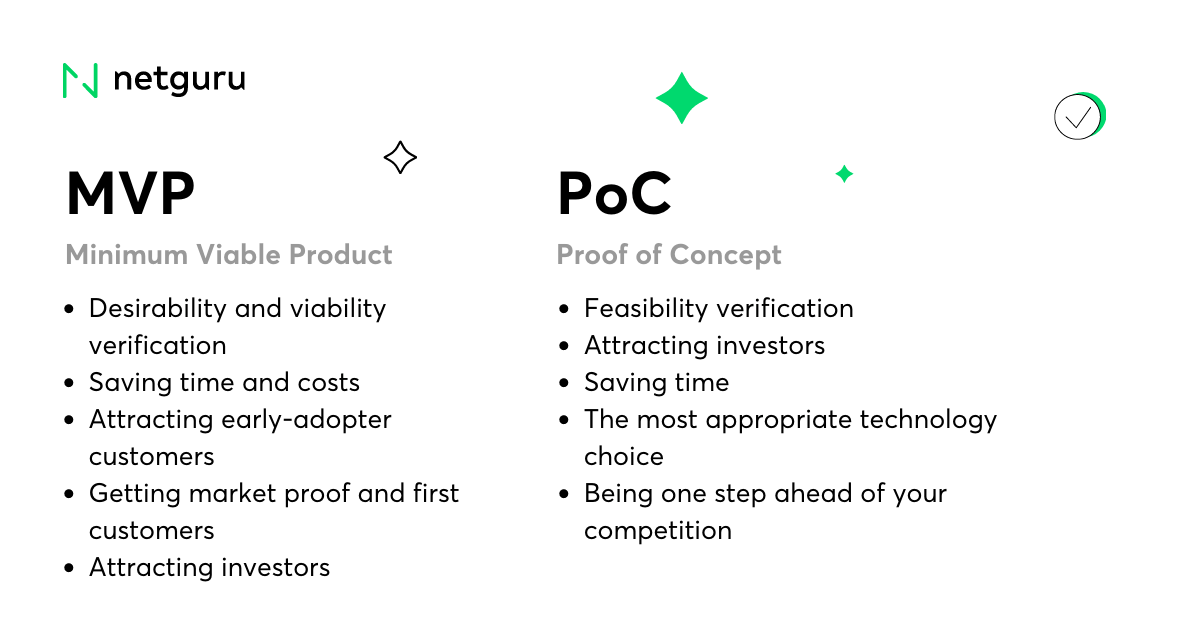
A proof of concept is an experiment, usually performed internally. It provides a realistic overview of a potential project to determine its feasibility and is mainly utilized to verify technical concepts.
These concepts could include methodologies, technologies, or integrations along with scalability and rentability.
Being applicable in a range of sectors, it's a fundamental step when building a prototype to analyze its feasibility in the market.
Essentially, it is an evaluation tool for determining if it is possible to build the product using given resources and technology.
In conclusion, both methods are very useful in product management and are used to verify different hypotheses regarding the product.
A good thing about MVP is that it allows you to fail fast (or succeed quickly) without spending a fortune on validating your business idea.
Piotr Szczechowiak, Product Manager in Netguru
Benefits of an MVP
Benefits of a PoC
Why is an MVP important?
So, we know what an MVP is. Now, let’s take a look at why Minimum Viable Product is important for businesses.
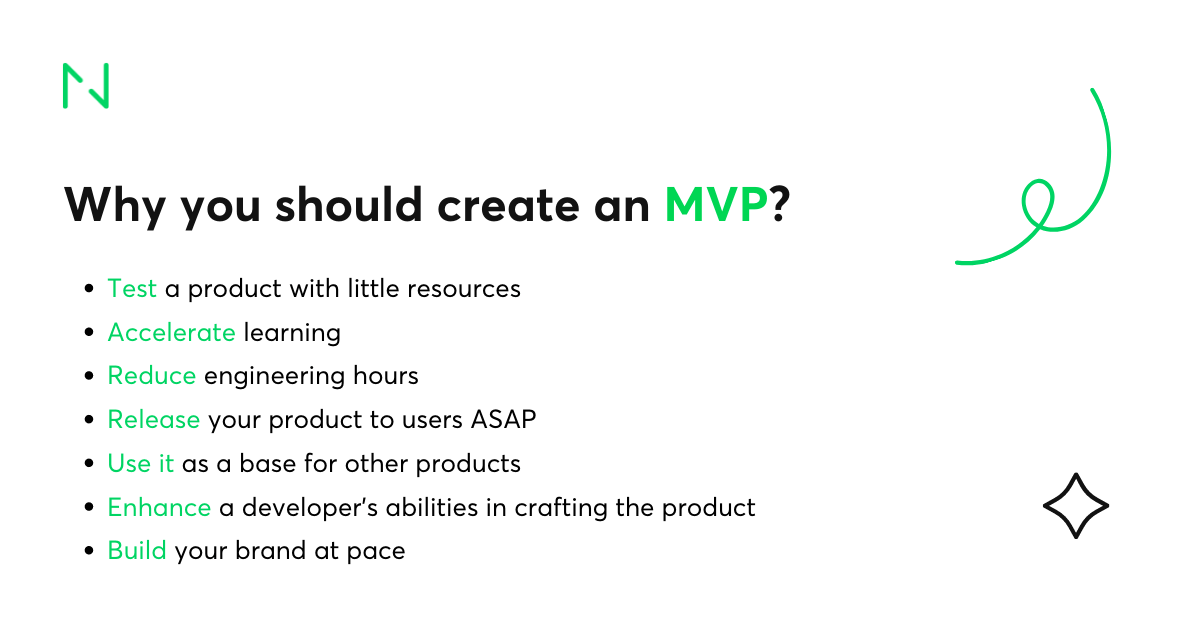
In short, a Minimum Viable Product lets you develop something that addresses the initial concerns of your audience in a timely manner.
The concept of an MVP can enable you to build products with little to no risk. The MVP process also enables you to determine the minimum requirements that will work for your user base for a new product.
Once you have determined those minimum requirements, you can quickly release a no-frills version of your product or service and use the results and feedback to refine and enhance the product.
In essence, MVP product development allows for real-time improvement and agility.
Agile MVP not only improves a product or service you are looking to release, but helps to streamline workflows and save huge amounts of development and maintenance time further down the line.
It is important to understand, however, that proceeding with an MVP framework for product development requires an understanding that your product will not be ready straight away, and if your customers aren’t satisfied, more work will be required to bring your MVP up to standard for a full product release.
There are many pros of building an MVP before going ahead with full product development:
The ability to understand target audience preferences is vital for any business, whether you’re a new start-up or a giant corporation.
As such, the ability to effectively roll out a Minimum Viable Product is an important capability to have in an increasingly dynamic and competitive market, where customers faced with a wealth of choice are free to choose another brand if their needs are net met.
With that in mind, you should consider adding the minimum viable product process into your overall strategy for customer acquisition and retention.
In addition, because the MVP framework allows you to validate an idea for a product without building the entire product, it can also help minimize the time and resources you might otherwise spend in product developing, providing a dual benefit of resource optimization with actionable market research and agile development.
Let’s recap on some of the main purposes an MVP can be used for:
Crucially, using the MVP framework to validate new ideas is essential in today’s market, in which technological innovation is reducing time-to-market for all organizations, and therefore demanding that brands move at speed to release viable products to the market.
In this context, the MVP allows you to take an agile approach to product development, gathering and implementing feedback from the earliest possible stage in the product life cycle.
Essentially, MVP product development enables you to crystallise and determine your brand and product vision in the right direction - with less guesswork and more hard data.
The rate of technological change occurring all of the time now means this will be crucial for brands looking to excel rather than fall behind.
What is the purpose of an MVP?
Eric Ries described the purpose of Minimum Viable Product development as:
MVP, despite the name, is not about creating minimal products. If your goal is simply to scratch a clear itch or build something for a quick flip, you really don't need the MVP.
A company might build an MVP for a number of reasons, which we’ll shortly describe, but the common theme in all of these reasons is the desire to learn more about how a product might work and how your audience will react to it.
This is the central purpose of an MVP: to learn and to improve.
Let’s take a look at some of the reasons a company might look to build MVP.
Some businesses end up releasing an MVP because their product team has an ambition to:
This is not an exhaustive list of MVP purposes but allied to the benefits we listed in the previous section, you can begin to build a clear picture of how and why a minimum viable product can be used to help drive forward effective innovation within your organization.
In the next section, we’ll give you a checklist to go through in the process of creating a Minimum VIable Product.
It’s important to note, however, that this is NOT a minimum product, but a workable product without frills.
This gives your programmers the flexibility to understand the product better and also test it in an environment with all risks and understand the user’s needs.
Whatever your reason for developing a Minimum Viable Product, there are a few steps you can take to help ensure the process is efficient and productive. Let’s take a look at the MVP checklist.
Your MVP checklist - a minimum viable product roadmap
Before you begin on your MVP, it’s important to be able to differentiate two types of MVP building: building for mobile applications, or building for web applications.
In terms of the technical aspects, there is not a huge degree of difference apart from which technology you choose to use to build the product itself.
Nevertheless, because an MVP is supposed to be a quick, simple first step towards iterative development, you need to know which market and platform to explore first.
If you don’t, you risk going into the project with a split focus, which won’t help you get the best out of an MVP.
It can often be quicker to launch an MVP for the web due to a lack of certification and acceptance protocols to pass.
You won’t have to worry about placing the product on an appropriate application store. Interestingly, some of the biggest web companies in the world - like AirBnb and Facebook - began with web apps before expanding with mobile apps later on.
However, it should go without saying that if most of your market is mobile, a web MVP won’t serve you as well.
Crucial to remember is that the mobile market is divided between two major platforms: iOS and Android.
If your ambition is to enter both of these stores, it makes sense to look for a technology that offers multi-platform development (like Flutter or React Native).
Best practices for developing MVPs
As with anything, there are good ways and bad ways to go about developing a minimum viable product.
Let’s take a look at some of the best practices first.
1. Set out your business needs and conduct preparatory market research
An important first step is to clearly define the business needs and objectives your MVP needs to meet.
Sometimes this is easy.
When it isn’t, however, a Product Design Sprint can help you to avoid any errors. Generally, projects don’t end up being successful by accident.
They are successful because they solve a real challenge or issue, so make sure you have the challenge clearly defined before you begin.
You can do this by conducting market research as a first step.
Solicit feedback from important stakeholders like investors, customers, industry experts and others. It’s always possible that a similar solution is already out there on the market.
This doesn’t necessarily mean your idea will be worthless. In fact, understanding the perception and success of similar products can help you to improve upon them or find a specific niche to fill.
2. Know which features are essential to your products, and which ones are bonus or nice-to-have features
Next, make a list of the features and functions your product will have to create value for your users.
The next step is listing all the features you want your product to have which will create value for your customers.
Do this by mapping the user journey, and how they flow through that journey as they interact with your product, making sure to focus in on usability.
Of course, you also need to know what your product’s unique selling proposition (USP) is, so you can use your MVP to evidence what makes your product special.
When this list is written, divide the features into three categories: essential, good to have, and extras.
In this way you can narrow down what are the essential elements of your product and thus what you need to build, as well as who to hire.
3. Consider running a proof of concept phase
As we mentioned before, a proof of concept can be extremely useful for early stage validation of technology, and can have the added benefit of building belief amongst your strategy and development team, investors and other stakeholders that your MVP stands a good chance of success.
4. Map out your criteria for success
If you don’t know what you’re aiming for, you will never know if your MVP is successful.
Therefore, make sure to define a measurable set of criteria or KPIs that will help you decide which aspects of your product are worth spending more time and resources to develop.
5. Measure your progress
Once the previous four steps are complete, you can begin development. Following on from step 4, it’s important to measure progress and learn from it along the way.
This will help you use your time wisely and gain momentum by being switched on to feedback.
6. Minimum does not mean messy
Throughout this process, your focus should be on keeping in mind the ‘M’ in MVP. However, just because a product is the minimum workable version of itself, it doesn’t have to be messy or sloppy.
Your development team needs to be building the core functionalities of your product as necessary to cater to a defined problem, and nothing else.
But those core functions still need to be designed well and keep users engaged and interested. This defines the ‘viable’ part of minimum viable product: usable and effective in attracting more users.
7. Take advantage of the experts, don’t cut corners
As tempting as it may be, you can’t cut corners and expect to be able to come back and fix issues further down the line.
Similarly, take advantage of the expertise you have available in your team or agency, and don’t compromise when it comes to expert knowledge of your product.
You should treat your MVP as the most effective way to test and release a product quickly, but it’s crucial to remember that it still represents your brand.
Don’t go overboard with fancy functionalities, either. There is time for that once the core functions are validated and in place.
Always make sure to track user behavior and sentiment so you can learn about how your MVP works and improve on the initial idea behind it.
Additional thoughts to consider during your MVP journey:
As with any software development process, there are pitfalls that can arise if the process is flawed or not right for your company.
Common Pitfalls to avoid with Minimum Viable Product Development
Now that we’ve explored the best practice for developing MVPs, let’s take a look at pitfalls to avoid.
1. Ignoring the Marketing Research
While an MVP can help you validate product ideas and understand better what your audience wants, you do need to take time to conduct market research prior to building an MVP.
Before validating a specific product, you first need to do the research to validate the potential of that idea.
2. Choosing the wrong software development team
Whether you are developing your MVP internally or externally, it’s vitally important to put a team together with the required expertise.
That means multidisciplinary teams of professionals, from designers and developers through to engineers and PMs.
Watch our video here on how to build an innovative tech team from scratch:
3. Too much focus on excellence
We would all like to achieve perfection on the first try.
Unfortunately, that’s not a realistic expectation and holding too closely to the dream of excellence can actually harm the MVP process.
You do not need to polish your MVP design fully; it just needs core features, and no frills.
Otherwise you will become bogged down in minor adjustments and end up spending more budget than you need to on your MVP - only to then potentially find out that your audience doesn’t like it anyway.
4. Choosing the wrong MVP testing method
As we’ll explore in the following section, there are different types of MVP methodology, and you need to choose the one that’s right for your business model, product and audience.
Otherwise, you could end up leading your product development in the wrong direction and lose time, money and potentially reputation.
5. No Prototyping phase
Prototyping is an essential phase in any product development lifecycle, and the same also applies to developing a minimum viable product.
Many startups, in particular, skip this phase, eager to enter development as soon as possible, but you shouldn’t do this.
It allows you to solve numerous problems and makes the app development process much smoother.
6. Disregarding analytics and user feedback
Much like you can’t enter into building MVP without conducting market research, it would be a mistake to refine it through iterations without paying attention to the feedback you get from your users, or what the analytics tells you about its effectiveness.
Study the feedback you receive thoroughly, and identify areas or aspects of your product that could be optimised, dropped or added in line with this.
7. Insufficient scalability
The MVP scalability is an essential factor in the long term success of your product.
You need to make sure you are paying attention to both your product’s design and the demand for it, and act accordingly to prepare it for a sudden growth in demand.
You can avoid these pitfalls by following the steps outlined above in this section to ensure a smooth minimum viable product development process.
Methods for testing the MVP
As we outlined in the last section, building a minimum viable product requires a process-orientated approach, where ideas are generated, prototypes tested and customer response data gathered for analysis.
This is done cyclically and in iterations until you end up with a winning product - or realise that your idea is not viable.
There are various methods to test your MVP, including:
Let’s take a look at these in a bit more detail:
The Interview Method MVP
This one is fairly self-explanatory; you meet with potential customers or clients and ask them questions to gain an understanding of what they want from a product.
How do they envisage the look, feel and performance of the product? The interview method allows you to really get to grips with your customer’s perception of your ideated product.
The Landing Page method
A landing page is a dedicated page which businesses use to explain the key features of their product.
Customers will look for this type of page while they browse for their desired products and services, so it’s good to place a product demo on your landing page.
Additionally, you can embed feedback forms or surveys on these pages to solicit customer feedback on the product itself. In this method, the customer doesn’t actually get to interact with the product.
As a result, you’re more likely to get an understanding of what their ideal final product looks like than tips on how to specifically amend your current product.
The Smoke Test MVP
A smoke test MVP consists of building a website that allows your potential user to sign up. They are then asked a series of questions about their product preferences.
These questions are obviously linked to the key metrics for your own product, so you can try out different product descriptions to see which one lands better with potential customers and is more likely to be a success.
The Concierge MVP
The concierge MVP method is commonly used in the service industry.
Businesses using Concierge can actually meet their customers in person.
The important aspect of this is getting face-to-face feedback - what do they want? What do they expect from a product or service?
Based on this insight, you would then be able to explain your own product and price to these customers and gauge their reactions.
This is a good method for getting feedback from multiple customers.
Case Study: ‘Food on the Table’
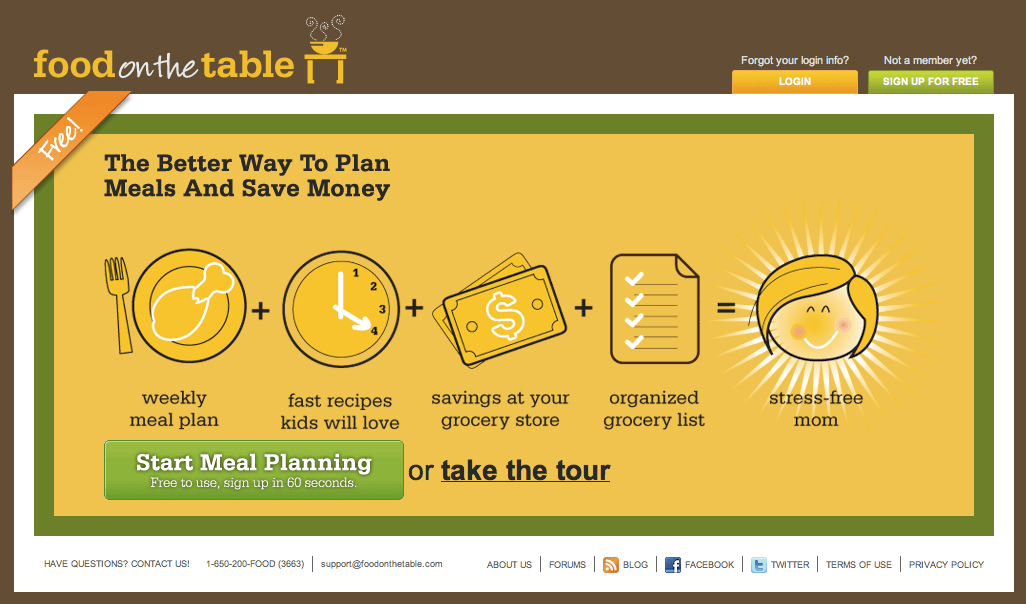
Source: Techuz
An example of the Concierge method in action is ‘Food on the Table’.
In this method, a company will serve customized meal ideas to potential customers online, and also send an ingredients list for that meal with the name of a grocery store they can be purchased from, with discounts highlighted.
This saves time for customers, especially working parents with little time to spare looking up recipes or searching for ingredients at a low price.
This company began when the CEO and founder went to meet his customers in person to suggest different recipes and ingredient lists. The service was payable by a subscription fee for a fixed period.
The Wizard of Oz
The Wizard of Oz bears some similarities to the Concierge method.
The main difference is that the customer doesn’t get to see the manual work done - it’s all behind the scenes. They see the product or service like any other regular portal, so they assume they are just using online services like any other.
This is a great way to see how your users react in a natural situation, with no observation (or not aware of any observation).
Case Study: Zappos
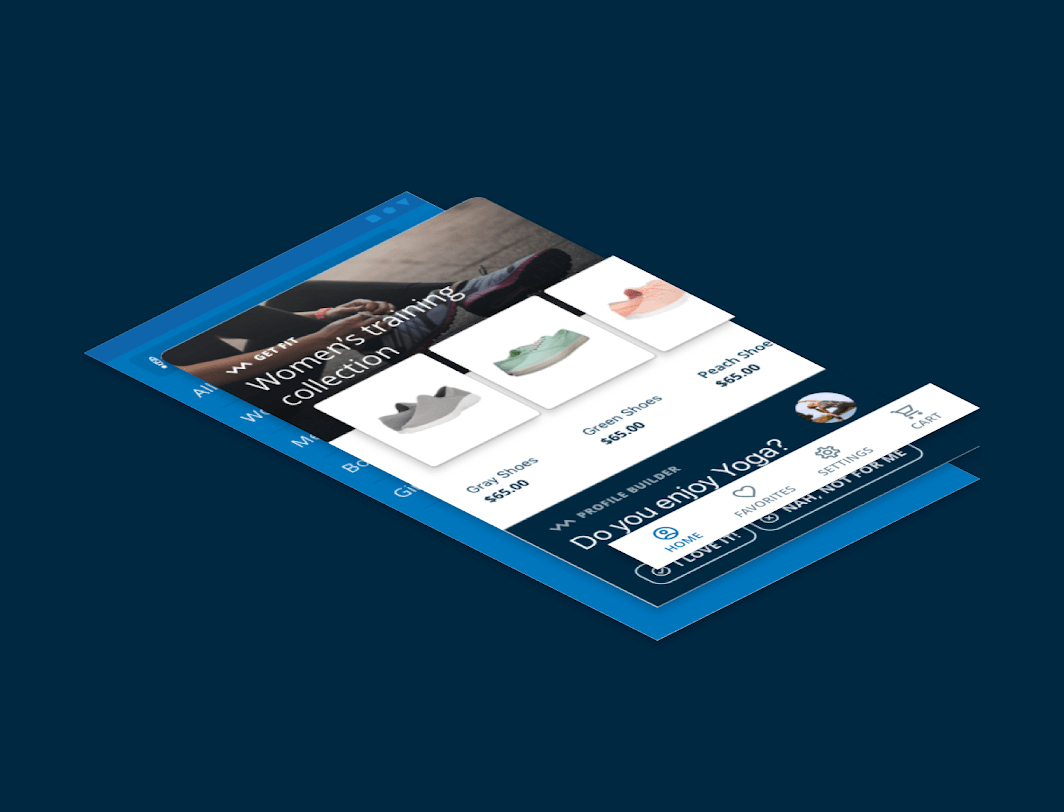
Source: Material.io
Nick Swinmurn, the founder of ‘Zappos’ started out by using the minimum viable product methodology.
He thought there was a gap in the market for people to buy shoes and other footwear online, as it would be easier and quicker than customers searching from store to store for the right brand, fit and price.
He tested this idea by advertising shoes online, with pictures. He didn’t manufacture these shoes himself; indeed, he didn’t even hold any footwear stock.
Instead, when he received an order, he went out, bought the pair from the store and delivered it to the customer himself.
This business model proved a success - Nick had validated his theory that there was a space in the market for purchasing shoes online, and as such he was able to attract investment for a full launch of the company.
Zappo’s success since then is evidence that the MVP approach works - if you can get it right.
The Piecemeal MVP
The Piecemeal method combines the best aspects of both the Concierge and The Wizard of Oz MVP.
In the Piecemeal, you develop a concept and provide a functioning demonstration of the product to your audience.
The product doesn’t have to be made, but your customer still gets a feel for it.
It’s important to note that this method doesn’t require investment in the infrastructure of the product - you just use the resources you already have available to you to make a demo of it.
The primary lesson to take from these different options is that you should never spend money on releasing new products without being sure that the idea is viable for success.
You need to study your product or service thoroughly in order to identify which of these methods is best suited to testing your MVP.
The major thing to take from this list of different MVP testing approaches is that one should not spend money on new products without being sure that the product will be a success.
There are various methods to find the MVP with adequate quality and quantity of feedback, and an appropriate level of confidence in the success of the product should you go forward to a full launch into the market.
Proper study and testing can help you to avoid pitfalls related to MVP development, as we listed in the previous section.
Real-world examples of Minimum Viable Product
Perhaps the best demonstration of how impactful a minimum viable product for business can be is the fact that some of the world’s most successful companies have used them.
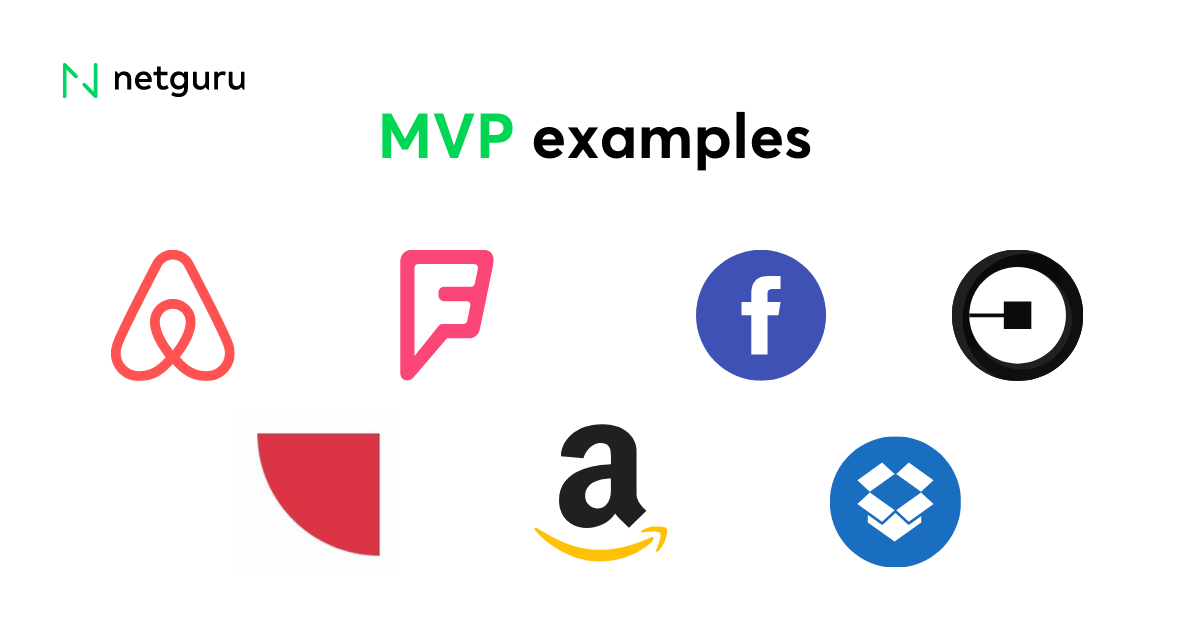
It’s harder to find a successful business that hasn’t tested an MVP than those who have.
Buffer, for example, is an account management and scheduling solution for social media. It began life as a simple 2-page website.
Buffer’s founder followed Eric Ries’ lean methodology by presenting his product idea on his site, testing how users responded to it and the level of interest.
Dropbox, the file sharing and cloud storage giant, is another example. In the company’s early days, the founders of Dropbox faced a monetary challenge: they needed funds to overcome significant technological issues before they would be able to launch the MVP.
Investors were unable to understand their pitch, as they couldn’t try out the solution, and it was too innovative to imagine. To overcome this problem, Drew Huston created a video MVP, explaining what Dropbox can do.
Uber is another example.
Now a global leader in taxi and delivery services, they started out with a simple question: would ordering a taxi, by phone but without a call center, work?
To test this idea, they built an MVP app to connect users to drivers by using GPS for pickup locations.
This initial app was incredibly basic, testing only one feature. But it was successful, and was the validation needed to begin Uber’s expansion into one of the most successful tech companies in the world.
The market for image editing applications was already quite crowded when Instagram decided to launch.
This was also true for photo-sharing social media sites. However, Instagram was able to gain a foothold - and eventually dominance - in this market because they tested an MVP first.
The MVP was an app which allowed users to only share square photos and use a limited number of filters. Additionally, the MVP app was only released on iOS, which limited costs for development and certification.
This simple approach has clearly proved its worth, as Instagram’s expansion over the years has proven.
These aren’t the only companies to successfully implement an MVP. Here are some more:
Amazon
Jeff Bezos started Amazon by making a list of 20 products that could be effectively marketed over the internet. Eventually, he got this down to five: books, compact discs, computer software, videos and computer hardware.
Finally, he identified books as the best option, and built an MVP of the Amazon bookstore in order to build an audience.
Since then, of course, Amazon has gone on to continuously innovate and expand on its product offering, showing where a humble, testing approach can lead.
Foursquare
Foursquare began with a single feature: allowing users to check in at different locations to earn badges.
This gamification generated engagement and excitement amongst users, and once a solid audience base was established, the app was expanded to become a full city guide.
Airbnb
The idea for AirBnb first came about in 2007, when roommates Joe Gebbia and Brian Chesky were struggling to pay their rent.
They decided to turn their apartment into a bed and breakfast, and their minimum viable product consisted of a simple website with a listing of their property that was specifically directed to people attending a design conference around the time.
Eventually, the listings were opened up so that customers could be paired with accommodation locations across the country and then the world.
The world’s largest social media site began life as a basic tool to connect with friends.
Profiles were as basic as possible and membership was limited to Mark Zuckerberg’s fellow students at Harvard University.
The idea proved popular enough to be worth expanding, and the platform gradually added more complex features - and the rest was history.
Lunching
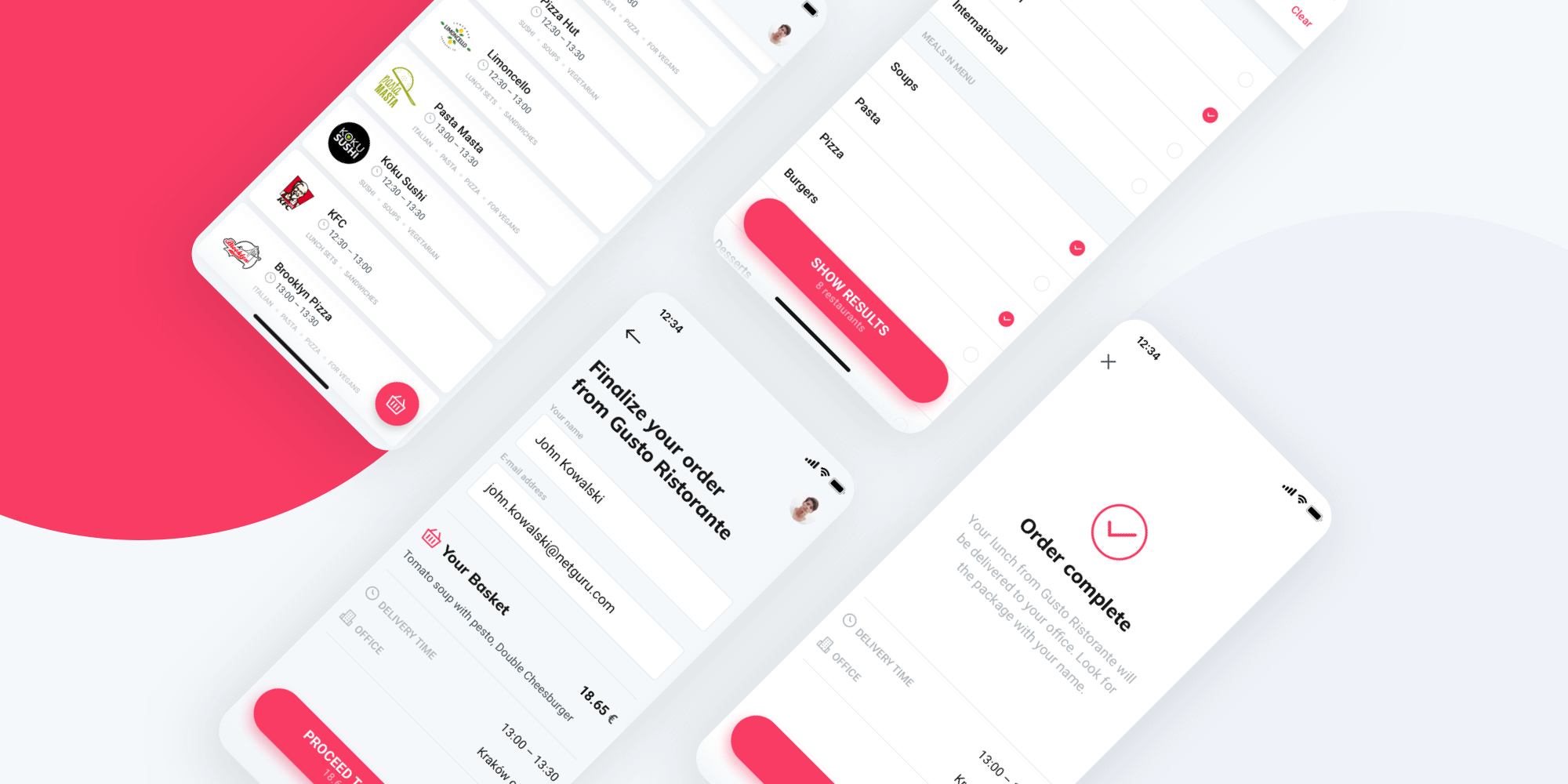
One of its Flutter’s key features relative to MVP development is the dedicated UI widgets engine that can enable you to create flexible user interfaces that look great, but can also be changed or improved upon easily. Y
ou can customise existing widgets, but it’s also incredibly easy to create your own ones from scratch.
Flutter is ideal for cost and resource effective MVP development because you can make changes rapidly, and because it's a cross-platform tool.
You don’t need to go through the decisioning process to choose the right platform for your product, and will also have a much broader pool of potential customers to get feedback from.
At Netguru, our Research & Development department loves testing new tools to learn about their capabilities.
Our team did this for Flutter as well by designing and testing a prototype for a food ordering application. We took the most popular food apps on the market as our inspiration.
First, we got a Senior iOS Developer and a Senior Android Developer to research the potential direction of the platform.
They created guidelines and gathered as much educational material as possible so that our team of developers could move smoothly into the new framework.
One of the things we found was that Flutter’s entry threshold for mobile developers is quite low, meaning they were able to familiarize themselves with it quickly.
It turned out that we could deliver this project using only the two Senior Developers already mentioned and a React Native Developer. The whole process - including the stage of familiarization - and implementation of a food delivery app took us two months.
As you can see, minimum viable product development has worked well for some of the world’s most successful enterprises - indeed, in some instances it was crucial in laying the groundwork for that success.
And as shown in our Lunching case study, it is also perfect for proofing new concepts and building a minimum viable brand to allow start-ups to get off the ground.
What comes after the Minimum Viable Product?
The step that comes after a minimum viable product is a Minimum Marketable Product (MMP). An MMP readies your MVP to be marketed to your target market.
Product management expert Roman Pichler says that:
The MMP describes the product with the smallest possible feature set that addresses the needs of the initial users, and can hence be marketed and/or sold.
The MMP helps to decrease your product’s time-to-market. It can be launched more quickly than a fat, feature-rich one.
Minimum Viable Product vs Minimum Marketable Product
This might make it seem very similar to the way we have described MVP so far.
However, the MMP is a development and refinement of the work undertaken in the MVP stage, using the insights gained to work towards an MMP.
A minimum marketable product differs from an MVP as it is more ready for general, broad release.
Moreover, launch preparation activities have to take place for an MMP, for instance, creating advertising campaigns, or gaining certification.
So, how do you bridge the gap between your validated MVP product and the MMP stage?
The insights you gain from MVP testing should help you identify which features, in particular, make your product unique, and, most importantly, which features help users solve their problems in the best way possible, as well as identifying the best possible audience for your product idea.
A great MMP could be the result of multiple MVPs, and its purpose is to discover whether the market is ready to accept your product and whether you’ll be able to derive revenue from it.
Once you’ve sent your MVP out into the world, you need to start gathering data on its impact and performance.
This is important because the decisions of your customers will help you to determine what does and doesn’t work about your product and even potentially throw up some ideas as to how to optimise it.
From this data, you’ll learn about the performance of the initial features included, whether they need to be supported by further features or if they’re even necessary at all.
You will also learn why a customer decided to purchase your MVP, or why they chose to reject it.
Gather this feedback and data and break it down in user stories, perhaps considering creating user personas.
Use these chunked stories to inform your MMP design sprints, keeping in mind not just the initial desire or idea behind your MVP, but what the market research and testing phases have told you about how that idea will perform in terms of monetisation.
A great MMP could be the result of multiple MVPs, and its purpose is to discover whether the market is ready to accept your product and whether you’ll be able to derive revenue from it.
Related terms - an MVP glossary
Here is a list of minimum viable product related terms and concepts:
Agile methodology
Agile methodology is a type of project management process, mainly used for software development, where demands and solutions evolve through the collaborative effort of self-organizing and cross-functional teams and their customers.
The Agile methodology is a collection of principles that value adaptability and flexibility. Agile aims to provide better responsiveness to changing business needs and therefore focuses on enabling teams to deliver in workable increments.
Customer development
Customer development is a formal methodology for building startups and new corporate ventures. It is one of the three parts that make up a lean startup.
The process assumes that early ventures have untested hypotheses about their business model.
Landing page
In online marketing, a landing page, sometimes known as a "lead capture page", "single property page", "static page", "squeeze page" or a "destination page", is a single web page that appears in response to clicking on a search engine optimized search result, marketing promotion, marketing email or an online advertisement.
The landing page will usually display directed sales copy that is a logical extension of the advertisement, search result or link. Landing pages are used for lead generation
Lean startup
Lean startup is a methodology for developing businesses and products that aims to shorten product development cycles and rapidly discover if a proposed business model is viable; this is achieved by adopting a combination of business-hypothesis-driven experimentation, iterative product releases, and validated learning.
Minimum Marketable Product (MMP)
A Minimum Marketable Product (MMP) is the next practical step after MVP in the product development process.
While an MVP focuses on validating assumptions and learning about your users preferences, an MMP incorporates a core set of functionalities that addresses customer/ user needs, creates the desired user experience and can start creating quantifiable value for a business.
An MMP can be released to market with must-have functionality that can then be scaled and developed to incorporate bonus or ‘good to have’ functionalities.
Minimum Viable Product
A minimum viable product is a version of a product with just enough features to be usable by early customers who can then provide feedback for future product development.
A focus on releasing an MVP means that developers potentially avoid lengthy and unnecessary work
Product development sprint
In agile methodology, a sprint is a period (e.g., 14 days) in which an agreed-upon set of development tasks takes place.
Proof of concept
Proof of concept, also known as proof of principle, is a realization of a certain method or idea in order to demonstrate its feasibility, or a demonstration in principle with the aim of verifying that some concept or theory has practical potential.
A proof of concept is usually small and may or may not be complete.
Rapid product design
Following the logic of design thinking, rapid product design (or development) can be defined as the design of new products in the shortest time scale possible, whilst ensuring that the criteria of desirability, feasibility, and viability are met.
User experience
The user experience (UX or UE) is how a user interacts with and experiences a product, system or service. It includes a person's perceptions of utility, ease of use, and efficiency.
Improving user experience is important to most companies, designers, and creators when creating and refining products because negative user experience can diminish the use of the product and therefore harm business revenue and other positive outcomes.
Summary
What we have seen so far is evidence of why so many companies - and so many successful companies at that - are turning to the MVP product development concept to help validate their ideas and ultimately get further towards achieving their business goals.
From the potential for improved business revenue and brand reputation, we’ve also explored the different methods of testing an MVP of minimum viable product you can use - including the Concierge MVP and the Landing Page MVP, amongst others.
Beyond all of the jargon (and hopefully we cleared any of that up for you in the last section), the clear strength of minimum viable product development (and the associated concepts of MMP, is in its ability to help you truly understand your customers and what they need.
It’s a way to action market research and refine your products and services with agility and insight in real time. In today’s market - whatever industry you’re in - that’s increasingly vital to survival and getting ahead.
However, it’s also important that you avoid the pitfalls we also listed on this page, from ignoring that market research to failing to prepare your product for scalability in the event of a spike in user numbers or popularity upon broader release.
Remember, the key elements of an MVP are:
And perhaps we should return to where the concept of the minimum viable product was popularised, with this quote from Eric Ries:
As you consider building your own minimum viable product, let this simple rule suffice: remove any feature, process, or effort that does not contribute directly to the learning you seek.
If you follow the tips in this guide, and heed Eric’s words, you will be well on your way to creating a successful minimum viable product.
However, even if your product isn’t a hit right away, the process can still be invaluable, because you can ultimately identify where you want your brand to go, and how your products and services will be able to help you get there.
And when you engage with your target audience in a productive way - as you certainly will along the MVP roadmap - you’ll have a much greater chance of bringing them along with you.
Hopefully this guide has given you all the information you need to know regarding minimum viable product development and the processes around it, and given you an idea of where it might be helpful to your business.
If you’re still uncertain, get in touch and we can give you information tailored to your business or project.
We’re expert MVP developers and engineers with huge experience and a desire to help you succeed in the new, dynamic and challenging era of business.
Thanks for reading, and please don’t hesitate to get in touch if you want to continue the conversation about minimum viable product development.
Piotr Szczechowiak
Piotr Szczechowiak works as a Product Manager at Netguru.
